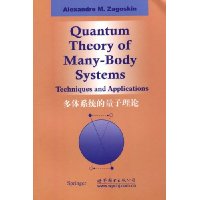| 商家名称 |
信用等级 |
购买信息 |
订购本书 |
|
|
 |
多体系统的量子理论(英文版) |
 |
|
 |
多体系统的量子理论(英文版) |
 |

基本信息·出版社:世界图书出版公司
·页码:229 页
·出版日期:2009年05月
·ISBN:751000490X/9787510004902
·条形码:9787510004902
·版本:第1版
·装帧:平装
·开本:24
·正文语种:英语
·外文书名:Quantum Theory of Many-Body Systems:Techniques and Applications
内容简介 《多体系统的量子理论(英文版)》内容为:This book grew out of lectures that I gave in the framework of a graduate course in quantum theory of many-body systems at the Applied Physics Department of Chalmers University of Technology and G6teborg University (Geteborg, Sweden)in the years 1992-1995. Its purpose is to give a compact and self-contained account of basic ideas and techniques of the theory from the "condensed matter" point of view. The book is addressed to graduate students with knowledge of standard quantum mechanics and statistical physics. (Hopefully, physicists working in other fields may also find it useful.)
编辑推荐 《多体系统的量子理论(英文版)》由扎勾斯凯所著。
目录 Preface
List of Tables
Basic Concepts
1.1 Introduction: Whys and Hows of Quantum Many-Body Theory
1.1.1 Screening of Coulomb Potential in Metal
1.1.2 Time-Dependent Effects. Plasmons
1.2 Propagation Function in a One-Body Quantum Theory
1.2.1 Propagator: Definition and Properties
1.2.2 Feynman's Formulation of Quantum Mechanics: Path (Functional) Integrals
1.2.3 Quantum Transport in Mesoscopic Rings: Path Integral Description
1.3 Perturbation Theory for the Propagator
1.3.1 General Formalism
1.3.2 An Example: Potential Scattering
1.4 Second Quantization
1.4.1Description of Large Collections of Identical Particles. Fock's Space
1.4.2 Bosons
1.4.3 Number and Phase Operators and Their Uncertainty Relation
1.4.4 Fermions
1.5 Problems to Chapter 1
Green's Functions at Zero Temperature
2.1 Green's Function of The Many-Body System: Definition and Properties
2.1.1 Definition of Green's Functions of the Many-Body System
2.I.2 Analytic Properties of Green's Functions
2.1.3 Retarded and Advanced Green's Functions
2.1.4 Green's Function and Observables
2.2 Perturbation Theory: Feynman Diagrams
2.2.1Derivation of Feynman Rules. Wick's and Cancellation Theorems
2.2.2 Operations with Diagrams. Self Energy. Dyson's Equation
2.2.3 Renormalization of the Interaction. Polarization Operator
2.2.4 Many-Particle Green's Functions.Bethe-Salpeter Equations. Vertex Function
2.3 Problems to Chapter 2
3 More Green's Functions, Equilibrium and Otherwise,and Their Applications
3. I Analytic Properties of Equilibrium Green's Functions
3.1.1 Statistical Operator (Density Matrix). The Liouville Equation
3.1.2 Definition and Analytic Properties of Equilibrium Green's Functions
3.2 Matsubara formalism
3.2.1 Bloch's Equation
3.2.2 Temperature (Matsubara) Green's Function
3.2.3 Perturbation Series and Diagram Techniques for the Temperature Green's Function
3.3 Linear Response Theory
3.3.1 Linear Response Theory. Kubo Formulas
3.3.2 Fluctuation-Dissipation Theorem
3.4 Nonequilibrium Green's Functions
3.4.1Nonequilibrium causal Green's function: definition
3.4.2 Contour Ordering and Three More Nonequilibrium Green's Functions
3.4.3 The Keldysh Formalism
3.5 Quantum Kinetic Equation
3.5.1Dyson's Equations for Nonequilibrium Green's Functions
3.5.2 The Quantum Kinetic Equation
3.6 Application: Electrical Conductivity of Quantum Point Contacts
3,6.1 Quantum Electrical Conductivity in the Elastic Limit
3.6.2 Elastic Resistance of a Point Contact: Sharvin Resistance, the Landauer Formula, and Conductance Quantization
3.6.3 The Electron-Phonon Collision Integral in 3 D Quantum Point Contact
3.6.4 "Calculation of the Inelastic Component of the Point Contact Current
3.7 Method of Tunneling Hamiltonian
3.8 Problems to Chapter 3
Methods of the Many-Body Theory in Superconductivity
4.1 Introduction: General Picture of the Superconducting State
4.2 Instability of the Normal State
4.3 Pairing (BCS) Hamiltonian
4.3.1 Derivation of the BCS Hamiltonian
4.3.2 Diagonalization of the BCS Hamiltonian. The Bogoliubov transformation. Bogoliubov-de Gennes Equations
4.3.3 Bogolons
4.3.4 Thermodynamic Potential of a Superconductor
4.4 Green's Functions of a Superconductor:The Nambu-Gor'kov Formalism
4.4.1Matrix Structure of the Theory
4.4.2 Elements of the Strong Coupling Theory
4.4.3 Gorkov's Equations for the Green's Functions
4.4.4 Current-Carrying State of the Superconductor
4.4.5 Destruction of Superconductivity by Current
4.5 Andreev Reflection
4.5.1 The Proximity Effect in a Normal Metal in Contact With a Superconductor
4.5.2 Andreev Levels and Josephson Effect in a Clean SNS Junction
4.5.3 Josephson Current in a Short Ballistic Junction.Quantization of Critical Current
in Quantum Point Contact
4.5.4 Josephson Current in a Long SNS Junction
4.5.5 "Transport in Superconducting Quantum Point Contact: The Keldysh Formalism Approach
4.6 Tunneling of Single Electrons and Cooper Pairs
4.6.1Coulomb Blockade of Single-Electron Tunneling
4.6.2 Superconducting Grain: When One Electron Is Too Many.
4.7 Problems to Chapter 4
A Landauer Formalism for Hybrid Normal-Superconducting Structures
A. 1 The Landauer-Lambert formula
A.2 Giant Conductance Oscillations in Ballistic Andrecv
Interferometers
References
Index
……
序言 This book grew out of lectures that I gave in the framework of a graduate coursein quantum theory of many-body systems at the Applied Physics Department ofChalmers University of Technology and G6teborg University in the years 1992-1995. Its purpose is to give a compact and self-contained accountof basic ideas and techniques of the theory from the "condensed matter" pointof view. The book is addressed to graduate students with knowledge of standardquantum mechanics and statistical physics. (Hopefully, physicists working in otherfields may also find it useful.)
The approach is - quite traditionally - based on a quasiparticle descriptionof many-body systems and its mathematical apparatus - the method of Green'sfunctions. In particular, I tried to bring together all the main versions of diagramtechniques for normal and superconducting systems, in and out of equilibrium(i.e., zero-temperature, Matsubara, Keldysh, and Nambu-Gor'kov formalisms)and present them in just enough detail to enable the reader to follow the originalpapers or more comprehensive monographs, or to apply the techniques to hisown problems. Many examples are drawn from mesoscopic physics - a rapidlydeveloping chapter of condensed matter theory and experiment, which deals withmacroscopic systems small enough to preserve quantum coherence throughouttheir volume; this seems to me a natural ground to discuss quantum theory ofmany-body systems.
文摘 插图:






